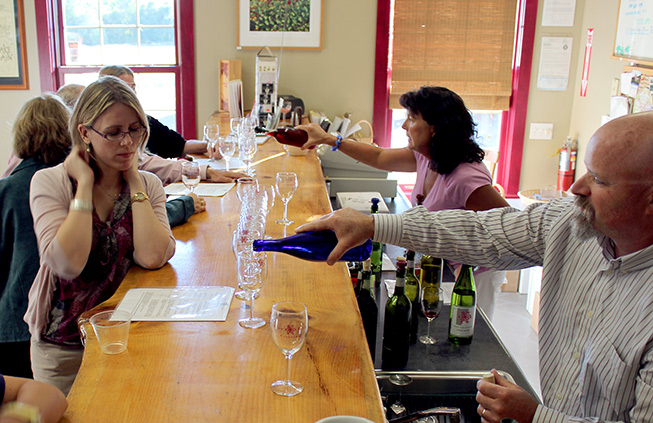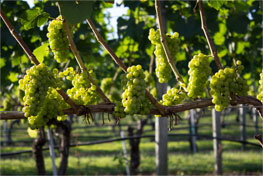Champlain Valley Wine Trail
 Winemakers in the Champlain Valley cultivate hearty northern grapes that yield distinct, award-winning wines. The craft of winemaking is growing every year, due in part to the region’s unique climate and soils. There are more than three dozen vineyards and wineries on the Wine Trail, so whether you’re looking for a dry white, a full-bodied red or a lush dessert wine, stop by a local winery and taste the terroir!
Winemakers in the Champlain Valley cultivate hearty northern grapes that yield distinct, award-winning wines. The craft of winemaking is growing every year, due in part to the region’s unique climate and soils. There are more than three dozen vineyards and wineries on the Wine Trail, so whether you’re looking for a dry white, a full-bodied red or a lush dessert wine, stop by a local winery and taste the terroir!

Photo: LCBP
A Brief History of Grape Growing and Wine Making in the Champlain Valley
A native species of grapes (Vitis riparia) thrives in New York, Québec and Vermont. These wild grapes were first documented on the St. Lawrence River by French Explorer Jacques Cartier in 1535. Almost a century later, Samuel de Champlain tried to transplant French grape vines for wine making, but the cold climate kept the plants from flourishing. While some wine was made from native grapes, the early French settlers to Québec and the Champlain Valley imported most of their wine from France.
The treaty ending the Seven Years War (known as the French and Indian War in the United States) ceded French control over Québec to the British in 1763. Trade then shifted to Great Britain, which produced spirits such as whiskey, rum and gin, with very little wine allowed in from France. It wasn’t until the 1970s that farmers in the region began to experiment with grape growing in earnest. By the 1990s, breakthroughs in enology (the study of grape growing/wine making) helped develop high-quality and disease resistant grapes that could thrive here.
These days, more and more of the landscape is dedicated to vineyards. And the award-winning vintages made here are bringing wine lovers to the region. Today there are dozens of vineyards with tasting rooms that welcome guests, allowing them to sample their wines. The Champlain Valley International Wine Trail was established to highlight these new additions to the region’s rich agricultural heritage.
Please Remember: Travelers crossing the border should remember duty and tax restrictions: after a two-day stay in the U.S., Canadians may bring two standard 750 ml bottles of wine home. Americans traveling to Quebec for more than 48 hours may return with up to one liter of wine. More than this amount may require paying a tax at the border.


